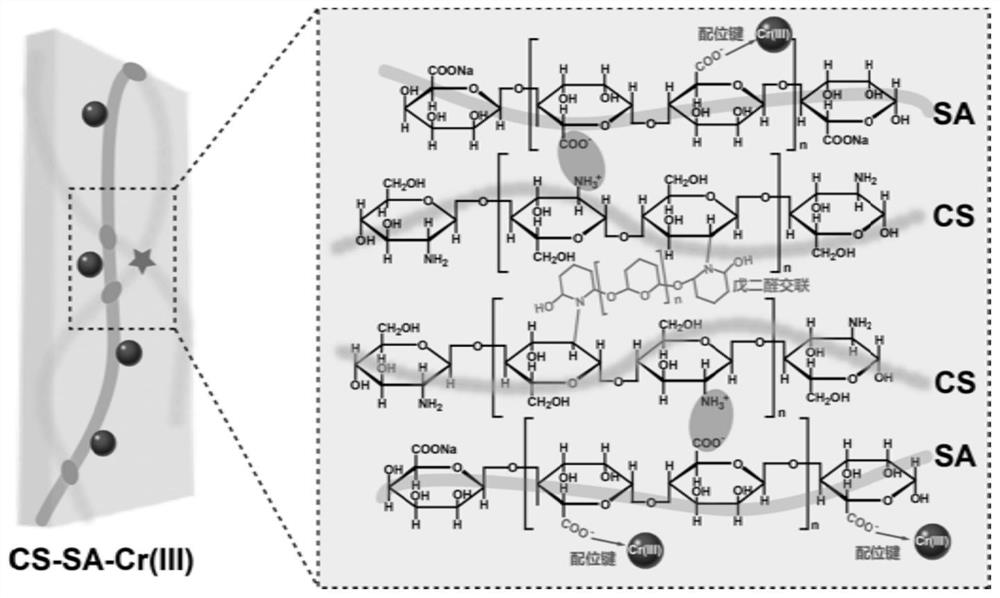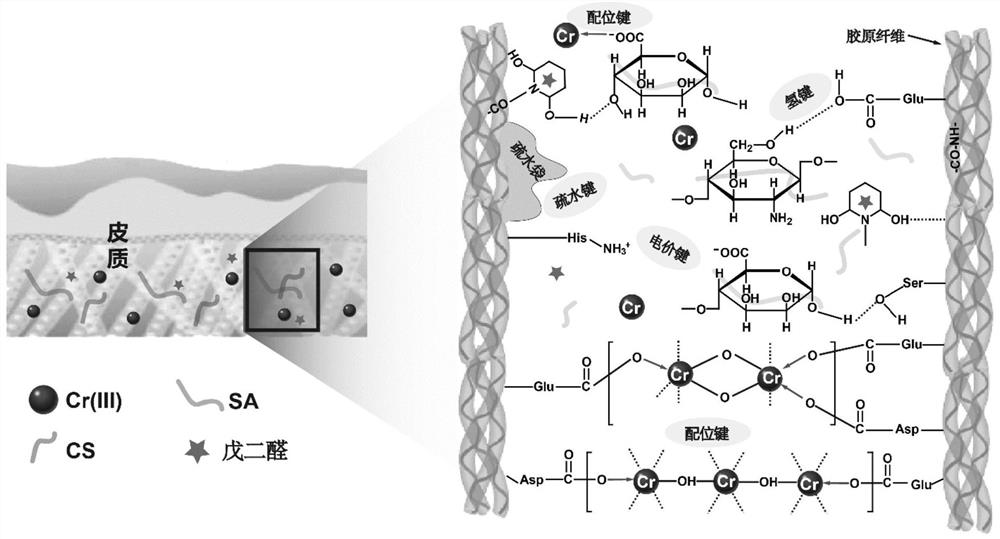Chromium-containing tannery wastewater treatment and resource utilization method based on natural biomass hydrogel
A technology of tannery wastewater and biomass, which is applied in animal processing wastewater treatment, water/sewage treatment, chemical instruments and methods, etc., and can solve problems such as time-consuming and complicated operations
- Summary
- Abstract
- Description
- Claims
- Application Information
AI Technical Summary
Problems solved by technology
Method used
Image
Examples
Embodiment 1
[0035] Step 1, preparation of CS-SA biomass hydrogel
[0036] Step 101, in parts by mass, dissolve 2 parts of sodium alginate (SA) in 100 parts of deionized water, and stir at 20°C for 40 minutes to obtain an SA solution; the viscosity of the sodium alginate is 180 Pa.s ;
[0037] Step 102, in parts by mass, dissolve 8 parts of chitosan (CS) in 200 parts of deionized water, and stir at 25°C for 60 minutes to obtain a CS solution; the viscosity of the chitosan is 400 mPa.s ;
[0038] Step 103: After uniformly mixing the SA solution obtained in step 101 and the CS solution obtained in step 102, add 2 parts of glutaraldehyde solution in parts by mass, and stir at 20°C for 10 minutes to obtain a slurry mixture Liquid; Described glutaraldehyde solution concentration is 25g / L;
[0039]Step 104. Put the slurry mixed liquid obtained in step 103 to stand under vacuum for 10 minutes, then pour it into a mold, expose the mold to a slow-release environment of glacial acetic acid, and r...
Embodiment 2
[0047] Step 1, preparation of CS-SA biomass hydrogel
[0048] Step 101, in parts by mass, dissolve 8 parts of sodium alginate (SA) in 200 parts of deionized water, and stir at 25°C for 60 minutes to obtain an SA solution; the viscosity of the sodium alginate is 220 mPa.s ;
[0049] Step 102, in parts by mass, dissolve 2 parts of chitosan (CS) in 100 parts of deionized water, and stir at 20°C for 40 minutes to obtain a CS solution; the viscosity of the chitosan is 200 Pa.s ;
[0050] Step 103: After uniformly mixing the SA solution obtained in step 101 and the CS solution obtained in step 102, add 4 parts of glutaraldehyde solution in parts by mass, and stir for 20 minutes at 25°C to obtain a slurry mixture Liquid; Described glutaraldehyde solution concentration is 25g / L;
[0051] Step 104. Put the slurry mixed solution obtained in step 103 to stand under vacuum for 20 minutes, then pour it into a mold, expose the mold to a slow-release environment of glacial acetic acid, an...
Embodiment 3
[0059] Step 1, preparation of CS-SA biomass hydrogel
[0060] Step 101, in parts by mass, dissolve 5 parts of sodium alginate (SA) in 150 parts of deionized water, and stir at 22°C for 50 minutes to obtain an SA solution; the viscosity of the sodium alginate is 200 mPa.s ;
[0061] Step 102, in parts by mass, dissolve 5 parts of chitosan (CS) in 150 parts of deionized water, and stir at 22°C for 50 minutes to obtain a CS solution; the viscosity of the chitosan is 300 mPa.s ;
[0062] Step 103. After uniformly mixing the SA solution obtained in step 101 and the CS solution obtained in step 102, add 3 parts of glutaraldehyde solution in parts by mass, and stir at 23°C for 15 minutes to obtain a slurry mixture Liquid; Described glutaraldehyde solution concentration is 25g / L;
[0063] Step 104. Put the slurry mixture obtained in step 103 under vacuum for 16 minutes, then pour it into a mold, expose the mold to a slow-release environment of glacial acetic acid, and react at 22°C...
PUM
| Property | Measurement | Unit |
|---|---|---|
| thickness | aaaaa | aaaaa |
| viscosity | aaaaa | aaaaa |
| viscosity | aaaaa | aaaaa |
Abstract
Description
Claims
Application Information
 Login to View More
Login to View More - Generate Ideas
- Intellectual Property
- Life Sciences
- Materials
- Tech Scout
- Unparalleled Data Quality
- Higher Quality Content
- 60% Fewer Hallucinations
Browse by: Latest US Patents, China's latest patents, Technical Efficacy Thesaurus, Application Domain, Technology Topic, Popular Technical Reports.
© 2025 PatSnap. All rights reserved.Legal|Privacy policy|Modern Slavery Act Transparency Statement|Sitemap|About US| Contact US: help@patsnap.com


